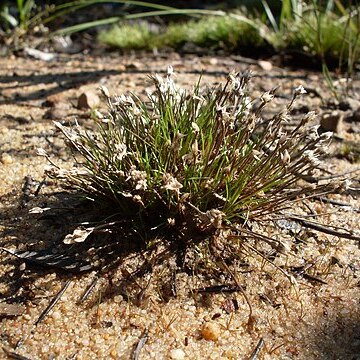Fls ∞, in a complex "spike" within 2 ± opp., unequal, glume-like bracts. Partial infls (pseudanthia) 1–8–(20) within each bract, each with 1–3, or 0 hyaline scales. ♂, 1 or 0 per pseudanthium with 1-celled anther. ♀, (1)–2–20 in each pseudanthium, ± connate and superposed in 1–2 rows, all styles free or ± connate at the base. Fr. dehiscing longitudinally. Small herbs, tufted and annual, or perennial and cushion-forming. Lvs linear-filiform and crowded at base of stem, or, in perennial cushion plants, densely imbricate up the stem, with stiff, terete, compressed or channelled lamina. Flowering stems slender, terminated by the 2 floral bracts and "spike". About 25 spp. chiefly in Australia, extending through Malaysia to Southeast Asia. Three N.Z. spp. are endemic and C. strigosa occurs also in Australia.
Small herbs, tufted annuals, or cushion-forming perennials. Leaves linear-filiform and crowded at base of stem, or, in perennial cushion plants, densely imbricate up stem, with stiff, terete, compressed or channelled laminae. Flowers numerous, in a terminal complex "spike" within 2 ± opposite, unequal glume-like bracts. Pseudanthia (partial inflorescences) within each bract 1-8-(20), each with 1-3, or 0 hyaline bracteoles. Male flowers 1 or 0 per pseudanthium with 1-celled anther. Female flowers (1)-2-20 in each pseudanthium, ± connate and superposed in 1-2 rows, all styles free or ± connate at base. Fruit dehiscing longitudinally. Spp. c. 25 of Australia, N.Z., Malaysia and S.E. Asia. C. strigosa of Australia is now regarded as adventive in N.Z., the other 3 N.Z. spp. are endemic.
Herbs, small, annual or perennial. Hairs unbranched or absent. Leaves basal with dilated membranous sheathing bases and linear to subulate 1-veined laminae; ligule absent. Inflorescence a terminal cymose head, often scapose on a single erect internode, enclosed by 2 primary bracts on a very short rachis. Secondary bracts 2 or 3 per pseudanthium or absent. Flowers arranged in 1–many sessile pseudanthia each comprising 0 or 1 male and 1–30 female flowers. Male flower with capillary filament. Ovaries within each pseudanthium superficially connate, alternating in 2 rows on a false axis (gynophore); styles at least partially free. Fruit compound, of connate 1-seeded follicles dehiscing abaxially. Seed ovoid to fusiform.
Herbs annual or perennial. Leaves radical or distichous; leaf blade linear to filiform. Inflorescence a head subtended by 2 opposite, inequilateral bracts, flowering in a centrifugal sequence. Flowers usually bisexual, 1--13, in 1 or 2 rows when several, sessile. Bracteoles 1--3 per flower, unequal, hyaline, apex erose. Carpels 3--20 per carpophore, in 1 or 2 rows, free or connate. Style 1 per carpel, free or connate at base; stigma papillose. Mature carpels dehiscing longitudinally.

